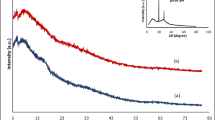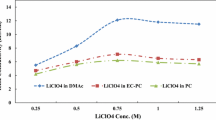Abstract
Copper-ion conducting gel polymer electrolyte (GPE) systems based on polymer poly(vinyl alcohol) (PVA) and copper sulphate salt doped with glycerin as plasticizer have been synthesized by using solution casting technique. Differential scanning calorimetry (DSC) is used to examine the thermal effect of glycerin on a polymer electrolyte. With the addition of various quantities of glycerin, as a plasticizer in pure PVA and PVA + 20 wt% CuSO4 polymer electrolyte shows a decrease in the values of melting temperature, glass transition temperature and percentage of crystallinity. From TGA curves, it is observed that thermal degradation of the glycerin doped polymer electrolyte is shifted towards lower temperature when compared to pristine PVA and the weight loss of the polymer electrolyte increases with increase of glycerin concentration. From DTG analysis, the temperature of maximum decomposition for PVA is 283.4 °C and it is decreased by the addition of 20 wt% CuSO4 and upon increased concentration of the plasticizer from 1 to 3 mL of glycerin. For pure PVA and PVA + 20 wt% CuSO4, ε′ decreases with increasing glycerin concentration and is lowest at 3 mL glycerin concentration. The maximum ionic conductivity obtained was 9.39 × 10− 4 S/cm for PVA + 20 wt% CuSO4 + 3 mL glycerin gel polymer electrolyte. The above results suggested that, the optimum conducting sample is suitable as separator in rechargeable batteries.






Similar content being viewed by others
References
J. Rodríguez-Varela, I.L. Alonso-Lemus, O. Savadogo et al., Overview: current trends in green electrochemical energy conversion and storage. J. Mater. Res. 36, 4071–4083 (2021)
C.P. Grey, D.S. Hall, Prospects for lithium-ion batteries and beyond—a 2030 vision. Nat. Commun. 11, 6279 (2020)
S.B.D.S. Filho, L.V.F.D. Oliveira, R.D.S. Oliveira et al., Free-standing solid polymer electrolytes based on elastomeric material and ionic liquids for safer lithium-ion battery applications. Solid State Ion. 379, 115901 (2022)
Sh.M. Abdelcareem, M.K. Jawad, Investigate salts type and concentration on the conductivity of polymer electrolyte. Iraqi J. Phys. 17, 42–50 (2019)
A.A. Kareem, Preparation and characterization of silver self-metallization on polyimide. Polym. Polym. Compos. 30, 1–8 (2022)
Ch. Wen, Y. Chen, Ch. Wang, Ch. Peng, Sh. Lin, K. Huang, Properties of a gel polymer electrolyte based on lithium salt with poly(vinyl butyral). Ionics 24, 1385–1389 (2018)
N. Boaretto, I. Garbayo, S.V.S. Raj, Lithium solid-state batteries: state-of-the-art and challenges for materials, interfaces and processing. J. Power Sour. 502, 229919 (2021)
M. Hamrahjoo, S. Hadad, E. Dehghani, M.S. Kalajahi, H.R. Mamaqani, Poly(poly[ethylene glycol] methyl ether methacrylate)/graphene oxide nanocomposite gel polymer electrolytes prepared by controlled and conventional radical polymerizations for lithium ion batteries. Int. J. Energy Res. 46, 9114–9127 (2022)
W.L. Li, J.J. Tang, B.T. Li, Preparation and characterization of composite microporous gel polymer electrolytes containing SiO2(Li+). J. Inorg. Organomet. Polym. 23, 831–838 (2013)
C.M.S. Prasanna, S.A. Suthanthiraraj, Investigations of zinc ion dissociation in gel polymer electrolytes based on poly(vinyl chloride) and poly(ethyl methacrylate) blend on the addition of two different ceramic nanofillers. J. Inorg. Organomet. Polym. 29, 483–501 (2019)
S. Lorca, F. Santos, A.J.F. Romero, A review of the use of GPEs in zinc-based batteries. A step closer to wearable electronic gadgets and smart textiles. Polymers 12, 2812 (2020)
A.M. Abdullah, S.B. Aziz, M.A. Brza, Glycerol as an efficient plasticizer to increase the DC conductivity and improve the ion transport parameters in biopolymer-based electrolytes: XRD, FTIR and EIS studies. Arab. J. Chem. 15, 103791 (2022)
S.B. Aziz, O.G. Abdullah, S.R. Saeed, H.M. Ahmed, Electrical and dielectric properties of copper ion conducting solid polymer electrolytes based on chitosan: CBH model for ion transport mechanism. Int. J. Electrochem. Sci. 13, 3812–3826 (2018)
F. Ye, K. Liao, R. Ran, Z. Shao, Recent advances in filler engineering of polymer electrolytes for solid-state Li-ion batteries: a review. Energy Fuels 34, 9189–9207 (2020)
K. Perera, M.A.K.L. Dissanayake, P.W.S.K. Bandaranayake, Copper-ion conducting solid-polymer electrolytes based on polyacrylonitrile (PAN). Electrochim. Acta 45, 1361–1369 (2000)
M. Mohsin, A. Hossin, Y. Haik, Thermal and mechanical properties of poly(vinyl alcohol) plasticized with glycerol. J. Appl. Polym. Sci. 122, 3102–3109 (2011)
S.L. Agrawal, A. Awadhia, DSC and conductivity studies on PVA based proton conducting gel electrolytes. Bull. Mater. Sci. 27, 523–527 (2004)
G. Ayala, A. Agudelo, R. Vargas, Effect of glycerol on the electrical properties and phase behavior of cassava starch biopolymers. Dyna 79, 138–147 (2012)
J. Tarique, S.M. Sapuan, A. Khalina, Effect of glycerol plasticizer loading on the physical, mechanical, thermal, and barrier properties of arrowroot (Maranta arundinacea) starch biopolymers. Sci. Rep. 11, 1–17 (2021)
B.A. Abdulkadir, J.O. Dennis, M.F. Bin, A. Shukur, M.M. Elsayed, F. Usman, Preparation and characterization of gel polymer electrolyte based on PVA-K2CO3. Polym. Plast. Technol. 59, 1679–1697 (2020)
S. Chaurasia, M. Singh, M.K. Singh, P. Kumar, A.L. Saroj, Impact of ionic liquid incorporation on ionic transport and dielectric properties of PEO-lithium salt-based quasi-solid-state electrolytes: role of ion-pairing. J. Mater. Sci. Mater. Electron. 33, 1641–1656 (2022)
A. Arya, A.L. Sharma, Effect of salt concentration on dielectric properties of Li-ion conducting blend polymer electrolytes. J. Mater. Sci. Mater Electron. 29, 17903–17920 (2018)
M.F.Z. Kadir, S.R. Majid, A.K. Arof, Plasticized chitosan-PVA blend polymer electrolyte-based proton battery. Electrochim. Acta 55, 1475–1482 (2010)
R.I. Mattos, C.E. Tambelli, E. Raphael, I.D.A. Silva, C.J. Magon, J.P. Donoso, A. Pawlicka, Proton mobility and copper coordination in polysaccharide and gelatin-based bioblends and polyblends. Cellulose 21, 2247–2259 (2014)
Sh.M. Abdalcareem, M.K. Jawad, Effect of cation size on electrochemical properties of polymer electrolyte. Iraqi J. Phys. 17, 76–84 (2019)
G. Hirankumar, N. Mehta, Effect of incorporation of different plasticizers on structural and ion transport properties of PVA-LiClO4, based electrolytes. Heliyon 4, 1–26 (2018)
E.A. Swady, M.K. Jawad, Study FTIR and AC conductivity of nanocomposite electrolytes. Iraqi J. Phys. 19, 15–22 (2021)
A. Pawlicka, M. Danczuk, W. Wieczorek, E.Z. Monikowska, Influence of plasticizer type on the properties of polymer electrolytes based on chitosan. J. Phys. Chem. A 112, 8888–8895 (2008)
R.J. Abdulnabi, A.A. Kareem, Fabrication and characterization of high-performance crosslinked PVA/ PMDA doped with H2SO4. Iraqi J. Sci. 63, 2006–2016 (2022)
N.J.H. Almashhadani, UV-Exposure effect on the mechanical properties of PEO/PVA blends. Iraqi J. Sci. 62, 1879–1892 (2021)
H.K. Rasheed, A.A. Kareem, Effect of multiwalled carbon nanotube reinforcement on the opto-electronic properties of polyaniline/c-Si heterojunction. J. Opt. Commun. 42, 25–29 (2021)
N.M. Ali, A.A. Kareem, Ionic conductivity enhancement for PVA/ 20 wt% CuSO4 gel polymer electrolyte by using glycerin. Chalcogenide Lett. 19, 217–225 (2022)
Funding
The authors have not disclosed any funding.
Author information
Authors and Affiliations
Corresponding author
Ethics declarations
Conflict of interest
The authors have not disclosed any competing interests.
Additional information
Publisher’s Note
Springer Nature remains neutral with regard to jurisdictional claims in published maps and institutional affiliations.
Rights and permissions
About this article
Cite this article
Ali, N.M., Kareem, A.A. & Polu, A.R. Effect of Glycerin on Electrical and Thermal Properties of PVA/Copper Sulphate Gel Polymer Electrolytes. J Inorg Organomet Polym 32, 4070–4076 (2022). https://doi.org/10.1007/s10904-022-02417-7
Received:
Accepted:
Published:
Issue Date:
DOI: https://doi.org/10.1007/s10904-022-02417-7




